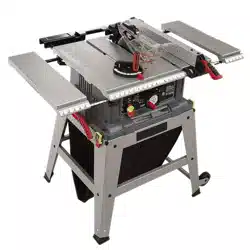Loading ...
Loading ...
Loading ...

addiUonai instructions for
CROSS CUT TYPE CUTS
Before starting
- NEVER use the rip fence when crosscutting.
- An auxiliary wood facing attached to the miter
gauge can help prevent workpiece twisting and
throwbacks. Attach it to the holes provided.
Make the facing long enough and big enough to
support your work, Make sure, however, it will
not interfere with the sawblade guard.
- Use jigs or fixtures to help hold any piece too
small to extend across the full length of the miter
gauge face during the cut. This lets you properly
hold the miter gauge and workpiece and hetps
keep your hands away from the blade.
While cutting
- To avoid blade contact, always hold the miter
gauge as shown in the BASIC SAW OPERA-
TIONS - USING THE MITER GAUGE.
BEFORE LEAVING THE SAW
1. Turn the saw off.
2. Wait for blade to stop spinning.
3. Make workshop child-proof. Lock the shop. Dis-
connect master switches. Remove the yellow
switch key. Store it away from children and
others not qualified to use the tool.
4. Unplug the saw.
GLOSSARY OF TERMS FOR WOODWORKING
Anti-Kickback Pawls (AKB)
Device which, when properly maintained, is design-
ed to stop the workpiece from being kicked back at
the operator during ripping operations.
Arbor
The shaft on which a cutting tool is mounted.
Crosscut
A cutting or shaping operation made across the
width of the workpiece.
Dado
A non-through cut which produces a square sided
notch or trough in the workpiece.
Featherboard
A device which can help guide workpqeces during np
type operations.
Freehand
Performing a cut without using a fence, miter gauge,
fixture, hold down or other proper device to keep the
workpiece from twisting during the cut.
Gum
A sticky, sap based residue from wood products.
Heel
Misalignment of the blade.
Kerr
The amount of material removed by the blade in a
through cut or the slot produced by the blade in a
non-through or partial cut.
Kickback
An uncontrolled grabbing and throwing of the work-
piece back toward the front of the saw during a rip
type operation.
Leading End
The end of the workp_ece which during a r_p type
operation, is pushed into the cutting tool first.
Molding
A non-through cut which produces a special shape
in the workpiece used for joining or decorat on.
Push Stick
A device used to feed the workpiece through the saw
during narrow ripping type operations and help
keep the operator's hands well away from the blade.
Push Block
A device used for ripping type operations too narrow
to allow use of a push stick.
Rabbet
A notch in the edge of a workpiece.
Resin
A sticky, sap base substance that has hardened.
Ripping
A cutting operation along the length of the work-
piece.
Revolutions Per Minute (RPM)
The number of turns completed by a spinning object
in one minute.
Sawblade Path
The area of the workpsece or table top directly in line
with the part of the workpiece which wil! be. or has
been, cut by the blade.
Set
The distance that the tip of the sawbJade tooth is
bent (or set) outward from the face of the blade.
Throw-Back
Throwing of pieces in a manner similar to a kickback.
Thru-Sawing
Any cutting operation where the blade extends
completely through the thickness of the workplece.
Trailing End
The workpiece end last cut bythe blade in a ripping
operation.
Workpiece
The item on which the cutting operation is being
done_ The surfaces of a workpiece are commonly
referred to as faces, ends, and edges.
Loading ...
Loading ...
Loading ...
